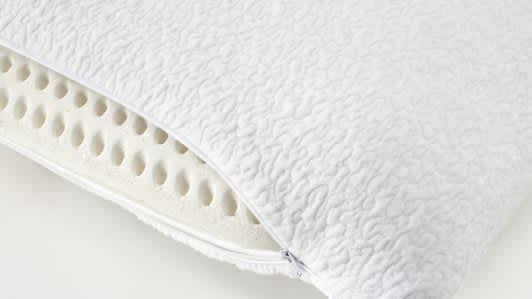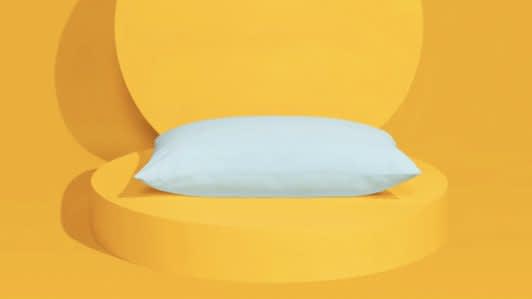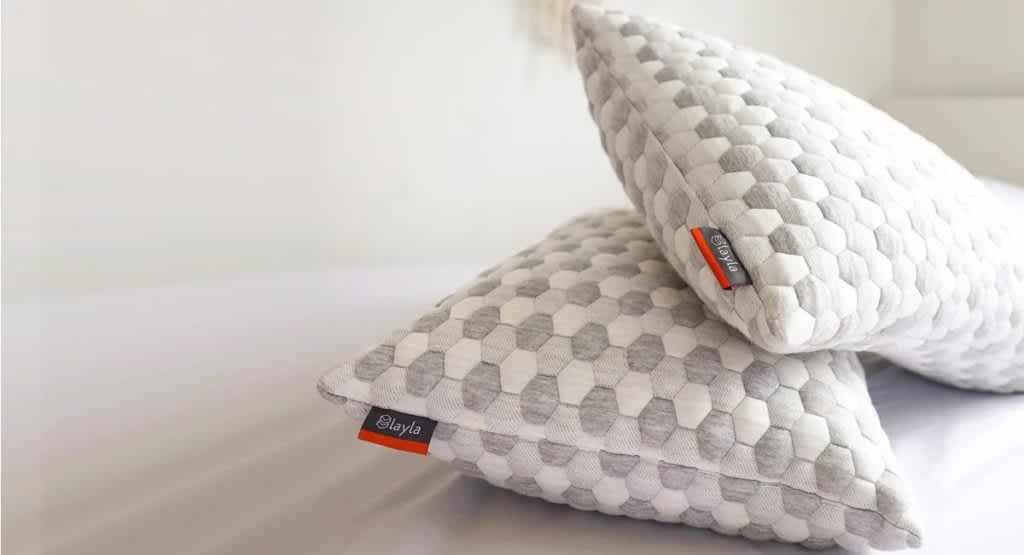On This Page
The Best Pillows for Back Pain
Our Top Picks
-
Best Overall Pillow
Sijo CloudSupport Pillow -
Best Value Pillow
Slumber Cloud UltraCool Pillow -
Best Pillow for Side Sleepers
Layla Kapok Pillow -
Best Pillow for Pressure Relief
Sleep Is the Foundation Shredded Memory Foam Pillow -
Best Cooling Pillow
Sijo FlexCool Memory Foam Pillow -
Best Luxury Pillow
Cozy Earth Silk Pillow
Best Overall Pillow

Sijo’s CloudSupport Pillow lives up to its name with a buoyant latex core that elevates your head and neck without causing strain. The latex provides some cushioning, but won’t conform like memory foam and maintains a full shape even when compression is applied. This level of shape retention means you’ll never need to fluff the pillow.
Highlights
Highlights
- Solid latex core is supportive and responsive
- Consistent breathability and temperature control
- Excellent shape retention
Ideal For
- Side and back sleepers
- People who run hot in bed
- Shoppers who want to invest in a long-lasting pillow
Full Details
Best Value Pillow

The Slumber Cloud UltraCool proves a pillow can deliver high-quality construction and solid performance while carrying an approachable sticker price.
Highlights
Highlights
- Outlast cover dissipates heat when it comes into contact with your skin
- Available in two firmness levels, as well as an adjustable option
- Plush down alternative fill provides deep cushioning
Ideal For
- People who are allergic to real down
- Hot sleepers
- Shoppers with limited budgets
Full Details
Best Pillow for Side Sleepers

The Layla Kapok pillow features the fibers of the kapok seed, an alternative to down with a slightly plusher, more robust feel that’s similar to silk.
Highlights
Highlights
- Kapok fibers are light and plush for a cloudlike feel
- Shredded memory foam offers responsive support without retaining heat
- Removable fill lets sleepers adjust the loft to their needs
Ideal For
- Those who tend to sleep hot
- Combination sleepers
- People looking for an affordable, natural alternative to down
Full Details
Best Pillow for Pressure Relief

Pressure buildup in the neck and shoulders can interfere with your sleep, but the right pillow can help alleviate this discomfort. Sleep Is the Foundation’s Adjustable Shredded Memory Foam Pillow is a prime example.
Highlights
Highlights
- Shredded memory foam infused with cooling gel adapts to your head and neck without too much heat retention
- Customizable for firmness and loft with supplemental fill included
- Ventilated cover helps promote air circulation
Ideal For
- Combination sleepers
- People with chronic neck or shoulder pain
- Those who want a pillow they can adjust
Full Details
Best Cooling Pillow

Heat buildup can be a sleep deterrent, but the pillow you use may help mitigate this problem. Sijo’s FlexCool Memory Foam Pillow features a nylon-blend cover that promotes airflow and feels cool to the touch at all times.
Highlights
Highlights
- Nylon-blend cover is exceptionally breathable and long-lasting
- Shredded memory foam provides deep cushioning and alleviates pressure
- Pillow can be adjusted by adding or removing the fill
Ideal For
- People who frequently wake up with stiffness or soreness in their neck and shoulders
- Combination sleepers who change positions during the night
- Value seekers
Full Details
Best Luxury Pillow

High-end materials in the Cozy Earth Silk Pillow balance exceptional softness with conforming comfort that lifts the head and neck for proper alignment. The combination makes the pillow an effective choice for back pain and creates an overall feel that’s satisfyingly luxe.
Highlights
Highlights
- Viscose cover has the look and feel of silk with the versatility of cotton
- Long-strand mulberry silk fill is highly breathable, durable, and moldable
- Transparent supply chain backed by socially responsible production techniques
Ideal For
- Those seeking a high-end pillow that balances comfort with performance
- Side sleepers under 230 pounds and back sleepers under 130 pounds
- Sleepers that run hot
Full Details
How We Test Pillows
We test pillows against the same set of strict standards that we use for other pillow types, but we pay close attention to several factors that set different pillows apart. In addition to firmness, conforming, and ease of cleaning, we also measure breathability. Many sleepers choose specific materials for their cool feel. To determine how well a pillow regulates temperature, we use thermal sensors that measure heat retention and we try them ourselves too, taking notes on how warm or cool we think a pillow feels after use.
What Is Back Pain?
Back pain is a broad term that refers to a number of sensations that cause discomfort in the muscles, bones, discs, ligaments, and tendons of the back. Pain may be sharp or dull in intensity, get worse with movement, or flare up in certain positions. Back pain can be acute or chronic, resulting from a variety of causes including age, weight gain, injury, poor posture, and under or overuse.
The structures of the back are needed for many basic activities like standing, walking, and turning. This means back pain can be disruptive to many aspects of daily life, including sleep, especially since it impacts over 80% of people at some point in their lives.
How Do Pillows Affect Back Pain?
Finding the right type of pillow can help to prevent or manage back pain. Matching your pillow’s firmness and height to your body type and preferred sleep position helps keep your head, neck, and spine in proper alignment. Proper spinal alignment is important to avoid the unhealthy postures that contribute to back pain.
One of the keys to combating back pain is making sure your neck isn’t bending to meet your pillow. Make sure you’ve got the right loft level — side sleepers need thicker pillows, stomach sleepers should use low-loft options, and back sleepers usually like something in between.
Choosing the Best Pillow to Help With Back Pain
Choosing a pillow with a loft and firmness that complements your sleep position can help manage back pain. The loft and firmness you need for healthy spinal alignment looks different depending on whether you’re a side, back, stomach, or combination sleeper.
Pillow Height (or Loft)
A pillow’s loft is how thick or tall it is. You may also hear it referred to as the pillow’s height or profile. Pillows typically have a loft of between 3 and 6 inches. Your sleep position plays a key role in choosing between a low, mid, or high loft pillow.
How Firm Should Your Pillow Be?
Like loft, firmness is also an important factor when selecting a supportive pillow. Pillows generally range in firmness from soft to extra firm. The right firmness level takes into account your preferred sleep position and individual preferences.
Support and Keeping Your Spine Aligned
In pillows, support is a function of both loft and firmness. When we talk about how supportive a pillow is, we’re referring to how well the pillow’s loft and firmness work together to align the spine. Finding a pillow with the right level of support for your personal needs is a key component of avoiding back pain.
The right level of support varies from sleeper to sleeper and depends on two factors: body type and sleep position. Lightweight stomach sleepers require a much different level of support than do heavier side sleepers. You’ll want to take both weight and size as well as sleep position into consideration when determining the level of support that works best for you.
Don’t forget about the option to use two pillows — one under your head and one in another spine-boosting spot. Knee, body, and wedge pillows can all take stress off your back while cushioning your joints.
What Type of Pillow Is Best for Back Pain?
There is no single pillow that works best for back pain as the right choice depends on an individual’s unique needs. In general, it’s best to match the loft and firmness of a pillow to a person’s body weight and sleep position. The best pillow is both comfortable and supportive, aligning the spine as it cushions the head and neck.
However, it’s worth noting that some types of pillows are usually more supportive than others. Those that use solid or shredded memory foam or latex typically have more of the responsive support that helps relieve pressure points and ease pain. Adjustable loft pillows can also be a good option as they allow for a more customized fit and can adapt to a sleeper’s needs over time.
Specialty Pillows to Alleviate Back Pain
Traditional rectangular pillows can work well for back pain, but there are other shapes and sizes that offer targeted support. Using these specialty pillows instead of, or in addition to, your regular pillow can be another way to alleviate back pain.
| Specialty Pillow Type | Description |
| Lumbar Pillow | Lumbar pillows are shaped like long, thin rectangles. They’re designed to fill the concave space at the base of the spine where the additional support can allow the muscles of the lower back to relax. |
| Cervical Pillow | Similar to lumbar pillows, cervical pillows or rolls fill the concave space between the base of the neck and head for added support. They can either be stand-alone or incorporated into a more traditionally shaped pillow. |
| Curved/Shaped Pillow | Curved or shaped pillows usually have ergonomically designed notches, divots, or rolls meant to accommodate the shoulders or cradle the neck and head. Their special shapes help maintain alignment. |
| Wedge Pillow | These triangular pillows can be placed under the knees for pressure relief or behind the back or sides to maintain a desired sleeping position. |
| Body Pillow | Body pillows are usually several feet long and can be used both as large bolsters to prevent rolling or as a “huggable” pillow that runs between the knees and curves beneath the head. |
| Pregnancy/Maternity Pillow | U-shaped pregnancy pillows curve all the way around the body, offering both body pillow options at the same time: a bolster to promote side sleeping as well as a knee, neck, and head support system. |
Tailoring your pillow selection and placement to your sleep position makes a difference in reducing pressure points that contribute to pain in your lower back, neck, shoulders, and hips. These small additions and modifications to your sleep environment can improve alignment and may reduce pain.
Side Sleepers
Besides ensuring that they have a pillow with enough loft and firmness to fill the gap between their shoulders and head, side sleepers should also consider placing a pillow between their knees. Lifting the upper knee away from the lower knee takes pressure off the lower back, allowing those muscles to relax.
Back Sleepers
Back sleepers typically need a pillow with mid-level firmness and support that keeps their heads and necks in a neutral position. They might add a wedge pillow or bolster below their knees for extra support. This can relieve tension in the lower back.
Stomach Sleepers
A softer pillow with a low profile helps keep the heads of stomach sleepers from tilting too far up, creating a pressure point at the base of the neck. Depending on their mattress, they may also want to place a pillow below their hips for added support.
Last Tips for Dealing With Back Pain
In addition to selecting a pillow that offers optimum levels of comfort and support, there are several other changes sleepers can make to find relief from back pain.
Find the Right Mattress: Just like with pillows, using a supportive mattress that works with your body type and sleep position to maintain spinal alignment can make a meaningful difference.
Overhaul Your Work Space: Spinal alignment shouldn’t stop at your pillow and mattress. If you work at a desk for most of the day, make sure your computer, chair, and worktop are ergonomically optimized.
See a Doctor: For acute or chronic back pain, it’s always best to see a doctor. They can look for the cause of back pain and recommend exercises and other therapies that can help alleviate pain and improve spinal health over the long term.
Explore More Pillows
If you’re looking for a particular type of pillow, check out our other guides below.
